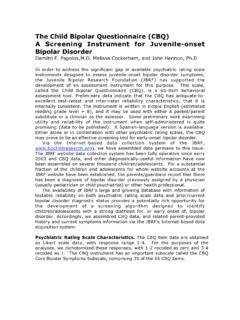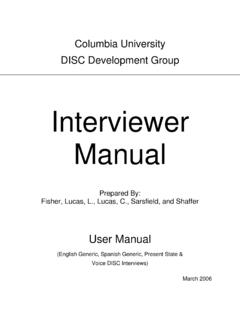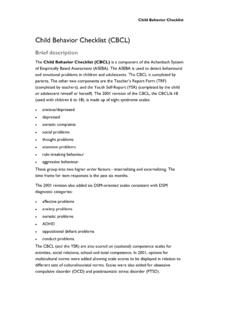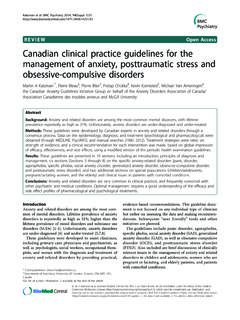Transcription of The Ritvo Autism Asperger Diagnostic Scale-Revised (RAADS ...
1 ORIGINAL PAPERThe Ritvo Autism Asperger Diagnostic Scale-Revised (RAADS -R): A Scale to Assist the Diagnosis of AutismSpectrum Disorder in Adults: An International Validation StudyRiva Ariella Ritvo Edward R. Ritvo Donald Guthrie Max J. Ritvo Demetra H. Hufnagel William McMahon Bruce Tonge David Mataix-Cols Amita Jassi Tony Attwood Johann EloffPublished online: 18 November 2010 The Author(s) 2010. This article is published with open access at Ritvo Autism Asperger Diagnostic Scale-Revised (RAADS-R) is a valid and reliable instrument toassist the diagnosis of adults with Autism Spectrum Dis-orders (ASD).
2 The 80-question scale was administered to779 subjects (201 ASD and 578 comparisons). All ASDsubjects met inclusion criteria: DSM-IV-TR, ADI/ADOS diagnoses and standardized IQ testing. Mean scores for eachof the questions and total mean ASD vs. the comparisongroups scores were significantly different (p\.0001).Concurrent validity with Constantino Social Responsive-ness Scale-Adult= Sensitivity=97%, specific-ity=100%, test retest reliabilityr=.987. Cronbachalpha coefficients for the subscales and 4 derived factorswere good. We conclude that the RAADS-R is a usefuladjunct Diagnostic tool for adults with Autism Asperger s disorder RAADS-RIntroductionThe RAADS was designed to address a major gap inscreening services for adults with Autism spectrum disor-ders.
3 With the increased prevalence of the condition andthe fact that adults are being referred or self-referred forservices or diagnosis with increasing frequency, thisinstrument is a useful clinical tool to assist clinicians withthe diagnosis of this growing population of higher func-tioning individuals in adulthood. This study was designedto standardize the Ritvo Autism Asperger DiagnosticScale-Revised (RAADS-R) in a large number of subjects atnine centers on three RAADS-R is a modified version of the Ritvo Aut-ism Asperger s Diagnostic Scale ( Ritvo et ). Therationale for its development was the need for a clinicaladjunct Diagnostic tool.
4 While several Diagnostic scales forchildren and adolescents with ASD are available (Attwood1998; Ehlers et ), only one peer- reviewed scale,The Autism -Spectrum Quotient (AQ) was designed spe-cifically for adults (Baron-Cohen et ). Its authorsemphasize that it is useful in identifying autistic traits andas a screening instrument but not as a Diagnostic tool. TheAQ is mailed in by the participant, unlike the RAADS-R,which is designed to be administered by a clinician ina clinical setting. Baron-Cohen et al. (2005) proposea Diagnostic system as well: The Adult Asperger sR.
5 A. RitvoThe Child Study Center, Yale University School of Medicine,New Haven, CT, USAE. R. Ritvo D. GuthrieThe Geffen School of Medicine at UCLA, Los Angeles, CA,USAM. J. Ritvo D. H. HufnagelYale College, New Haven, CT, USAW. McMahonUniversity of Utah School of Medicine, Salt Lake, UT, USAB. TongeMonash University, Melbourne, VIC, AustraliaD. Mataix-Cols A. JassiKing s College London, London, UKT. Attwood J. EloffGriffith University, Brisbane, QLD, AustraliaR. A. Ritvo (&)11941 Saltair Terrace, Los Angeles, CA 90049, USAe-mail: Autism Dev Disord (2011) 41:1076 1089 DOI (AAA): A Diagnostic Method. While theAAA is a good system, it is a complete diagnosticsystem, unlike the RAADS-R.
6 It is lengthy and compli-cated to administer and is still relatively new. The initialRAADS was developed around the same time original RAADS contains 78 empirically derivedquestions that assess symptoms based upon DSM-IV-TR(American Psychiatric Association2000) and ICD-10 World Health Organization (1992) Diagnostic criteria thatwere extensively tested prior to inclusion on the scale. Itproved accurate in discriminating autistic and Asperger ssubjects (N=37) from comparison subjects (N=57)when tested ( , sensitivity=1, specificity=1). Sev-enty-six of the 78 questions significantly distinguishedASD subjects from comparison subjects ( Ritvo et ).
7 Questions on the initial RAADS assess developmentalpathology in three symptom areas: language, social relat-edness, and sensory-motor (re: DSM-IV-TR). After criticalreview and the results of a factor analysis, a revised 80-item version was developed (the RAADS-R) with theaddition of a fourth symptom area (circumscribed inter-ests), two questions, and several word clarifications. Likethe RAADS, the RAADS-R is a self-report instrument,designed for adults (18?) with average or above order to validate the RAADS-R, a uniform researchprotocol was developed to be implemented at nine researchcenters on three continents.
8 The protocol assured unifor-mity of diagnosis and data acquisition, and its implemen-tation in multiple centers afforded an opportunity to assessthe applicability of the scale in a variety of internationalclinical settings: (a) UCLA; (b) The Child Study Center,Yale University; (c) University of Utah; (d) Mt. SinaiMedical School, New York; (e) The Geneva Center, Tor-onto, Canada; (f) King s College, London, England; (g)Monash University, Melbourne, Australia; (h) GriffithUniversity, Brisbane, Australia; and (i) ASPECT, Sidney, the time this research was concluding, the AmericanPsychiatric Association s DSM-V committee proposednew Diagnostic criteria for Autism Spectrum disorders (APA DSM-52010).
9 These new guidelines propose com-bining individuals who meet the DSM-IV-TR criteria forAutistic Disorder and Asperger s Disorder into one cate-gory called Autistic Spectrum Disorder (ASD). The resultsof this study will present subjects grouped according toboth the DSM-IV-TR and proposed DSM-V criteria. Therehas been ongoing controversy among clinicians about therelationship of Autism and Asperger s disorder. Diagnosticapproaches and definitions are described in the literature(Fitzgerald and Corvin2001; Klin et ; Volkmar andLord1998).MethodsParticipantsResearch Centers and Informed ConsentsNine centers on three continents were selected to provide aworldwide spectrum of English speaking subjects.
10 HumanSubject Protection Protocol and Consent to ParticipateForms were approved by the California InstitutionalReview Board, Pasadena, California for all UCLA subjects,and served as models for the other centers to assure uni-formity. Each center has ongoing clinical and researchprograms focusing on Autism , and each center compliedwith their rules and regulations concerning the protectionof human subjects. Each of the nine centers providedautistic and Asperger s disorder subjects and some alsocontributed comparison GroupingThe study population included 4 groups as follows: (a)subjects with a diagnosis of Autistic Disorder (n=66), (b)subjects with a diagnosis of Asperger s Disorder(n=135), (c) subjects with no previous DSM-IV-TRdiagnosis (n=276), and (d) subjects with an axis I DSM-IV-TR diagnosis other than Autistic Disorder, Asperger sDisorder, or PDD NOS (n=302).






